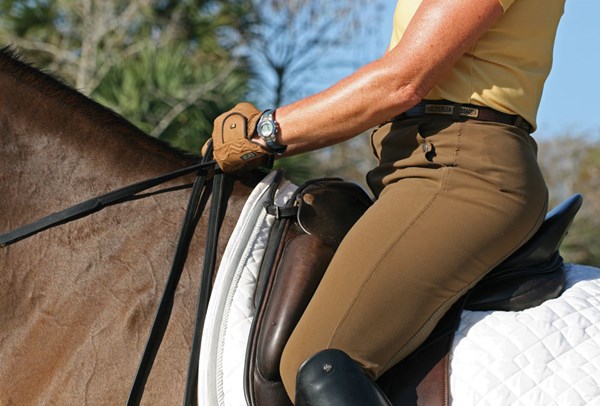Q: I would like some advice on how to ride a correct half halt. I feel that I need the reins, pulling them backward a bit for the half halt. After all, isn’t the half halt like a stop for the horse? What is wrong if I feel I need to pull on the reins for the half halt? —Sue Bessa of Chandler, Arizona
A: Pulling backward on the reins creates a tug-of-war between you and your 1,000-plus-pound horse, which you will eventually lose. A horse’s usual answer to a rider pulling is to push forward with his head, neck and chest. Horses who push into the bit may convince the rider to pull harder, thus continuing the tug-of-war. Riders in this situation often take on a water-skier position, shoving their heels down and forward and leaning back against the reins. Riding in this defensive way doesn’t allow for subtle communication and often ends up with a resistant horse and frustrated rider.

Unfortunately, you and your horse won’t discover self-carriage when rein tug-of-war is a normal occurrence because the horse’s jaw and neck will wind up stuck in a defensively locked position, prohibiting him from reaching softly for your hands. In turn, your hands wind up restrictive and slow to give, making it impossible to have the incredibly fast timing necessary to apply a sophisticated half halt in one phase of one stride, followed by an immediate release in the next phase.
Ideally, you and your horse should be so in tune that the spinal-cord-to-spinal-cord connection between your seat and your horse’s back lets him respond to the smallest change in weight. This communication allows you to apply a sophisticated half halt to rebalance your horse longitudinally.
The system of aids of a sophisticated half halt are:
• a minute calf lift/fluff to increase the energy,
• a pause in hip movement while slightly increasing the weight of your seat bones, and
• closing either one (usually the outside) or both hands into fists on the reins during a moment of increased tone in your forearms, triceps, latissimus dorsi and trapezius—lats and traps.
This aid system happens simultaneously during one phase of one stride and is immediately released during the next phase of the stride, concluding the half halt and resulting in the horse’s center of mass shifting further back in the body under your seat.
Half halts are often applied in quick succession, depending upon the degree of longitudinal rebalance required. The balance improvement enables your horse to carry and thrust more from his haunches and push off the ground with his front feet, while elevating the forehand through the thoracic sling muscles.
My description of an effective half halt assumes your horse is responsive to the slightest change in your seat, legs and hands. It also assumes you are vertically stacked up, toned and balanced in your torso with supple yet stable hips, knees and ankle joints functioning as shock absorbers and enabling your seat to stay in soft communication with your horse’s back. The term “stacked up” refers to the vertically symmetric column of your head–rib cage–core–pelvis alignment. Your column has to be supported by toned soft tissues: muscles, tendons and ligaments, all held in positive tension. The supported “stacked-up-ness” of your column and functional hip, knee and ankle joints acting as shock absorbers are biomechanical prerequisites for being able to execute the sophisticated half halt described above because this mechanism makes an independent seat and hands possible. Most riders haven’t developed this level of control, so they resort to what they already know: pulling back.
We instinctively pull to stop horses because it’s human nature to assert control with our hands and resist being pulled forward. Research shows that it takes 10,000 repetitions to replace a physical habit with a new one. So learning not to pull on the reins for a half halt takes time. Learning the specific timing to give a half halt comes after achieving the prerequisite stable, independent position and the quickness to apply the half halt/release within one phase of one stride. The timing of the phase in the stride is gait-dependent, and the horse’s specific leg influenced depends on the desired result: either to get the horse to push off the ground more or to sit and flex more. I’ll save the detailed discussion about timing for another time.
When you and your horse are both quick to react to the half halt, your horse will appear to float over the ground with a swinging back, beautifully arched neck and soft mouth reaching forward toward your receiving hand in perfect harmony and absent of mental tension. Horses show their pleasure in being allowed to carry themselves in balance through enhanced expressiveness, desire, thrust and energy. This perfect connection was recently described to me during a student’s moment of revelation as, “He’s actually seeking my contact, instead of me seeking his!”
Good luck with your 10,000 repetitions as you develop a more stable core, independent seat/hands and a harmonious relationship with your dance partner.

Jennifer Truett is a USDF “L” Education Program graduate with distinction, a USDF certified instructor through Second Level and a USDF silver and bronze medalist. She operates Dancing Horse Farm in Lebanon, Ohio.











